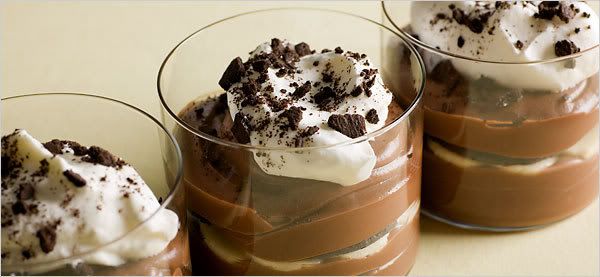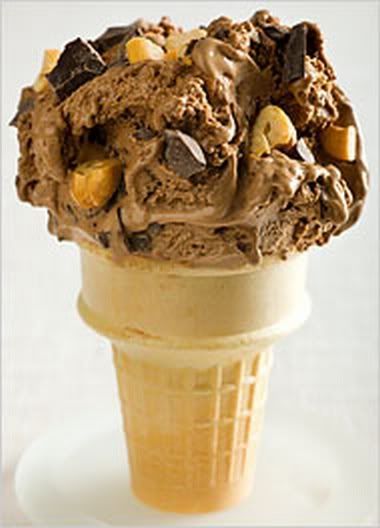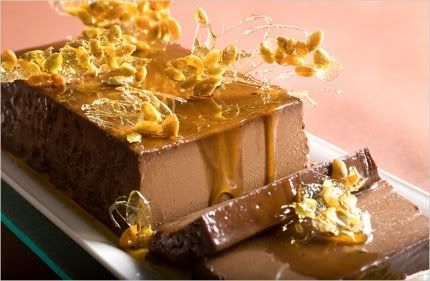Postres de Chocolate.
Dining & Wine | ||
| You Call That Pudding, Grandma? By MELISSA CLARK Published: April 23, 2008 | ||
 Francesco Tonelli for The New York Times Milk chocolate banana pudding with wafer crumbs. | ||
| I HAD no intention of making chocolate ice cream. I wanted only the perfect chocolate pudding. For years, when striving to make the ultimate, silky, profoundly fudgy chocolate pudding, I invariably looked to Grandma. Oh, not to either of my Grandmas, who relied on boxed mixes with pallid results. But to an iconic silver-haired Grandma whom I envisioned stirring a pot of farm fresh milk, eggs, cornstarch and melted chocolate to a creamy, intense perfection. For over a decade, I happily stirred my way through pudding recipes from the most tried-and-true grandmotherly sources I could find: Fannie Farmer and "Joy of Cooking," Better Homes and Gardens magazine, and spiralbound Junior League cookbooks. And all the puddings were pretty good jiggly and smooth, with addictive sticky skins that I greedily peeled off and ate while standing in front of the fridge. But none was quite good enough to send me back for more. At restaurants, chocolate pudding was an entirely different creature, one that had nothing to do with Grandma. Luscious and sexy, with a haunting bittersweet flavor and a texture like a silk camisole, it was less family matron than femme fatale. So what did these puddings have that mine didn't, other than possibly a whole lot of heavy cream? To find the answer, I called Deborah Snyder. Currently the pastry chef at Alto and L'Impero in New York, she is the author of a seductive chocolate pudding that's seared into my memory from a meal long ago at Lever House, where she used to work. I explained my pudding fantasy to her, and she quickly set me straight, booting my American grandmother out of the kitchen and installing a French grand-mère. The problem with the stove-top puddings I'd been stirring up, she said decisively, was the cornstarch, which interfered with the satiny feel and deep chocolate taste. | ||
 Francesco Tonelli for The New York Times Ice creams, like this chocolate-chocolate chunk with cashews, are related to puddings and custards. | ||
The pudding I craved was in fact a classic French pot de crème, basically a baked chocolate custard. Steamed long and slow in a water bath, baked custards use the thickening power of egg yolks to set the mixture: no starch required. I have made pot de crème many times, but never thought of it as a pudding. For a second opinion, I called another stellar dessert maker, Karen DeMasco at Craft in New York. (She is leaving the restaurant next month.) She quickly concurred, explaining that her gorgeously rich chocolate pudding is based on pot de crème. So why didn't her menu call it pot de crème or chocolate custard? "People respond to the word pudding," she said. "They have more of a connection to it than to custard." The chocolate pudding family tree originated with custards, which can be baked, steamed or stirred together on the stove like custard sauce or crème anglaise. Without chocolate, custards date at least to the Middle Ages. Custards usually rely on eggs to thicken a liquid, typically milk or cream. The idea of thickening custard with cornstarch came from Andrew Bird, an Englishman whose wife was allergic to eggs. In 1837 he began marketing his cornstarch-based Bird's Custard Powder, still a staple in the United Kingdom. Puddings using cornstarch quickly took hold in the United States, and in 1918 My-T-Fine put out the first boxed pudding mix. Whether made from scratch or a box, cornstarch puddings faster, more convenient and less finicky than baked custards became the American pudding standard. Eggs were often used for extra richness, but the primary binding was cornstarch. Back in my kitchen, I tried something new. If I wanted an American-style pudding that was ultraluxurious, the trick would be to reduce the cornstarch and increase the eggs and chocolate to compensate for the loss of thickening power. At the same time, I would make pot de crème and pit it against my best stove-top efforts. But why stop there? I'd also investigate flan, which is baked custard gilded with caramel. And what is ice cream? Frozen custard! | ||
 Francesco Tonelli for The New York Times Dark chocolate flan with pumpkin seed praline. | ||
| I started with cornstarch pudding, replacing much of the milk with heavy cream and adding extra egg to bring up the luxurious character. I figured a good brand of milk chocolate would intensify the sweet creaminess. The gentle milk chocolate flavor, I thought as I licked the spoon, made me crave a big bowl of whipped cream to eat with it, and it occurred to me that layering the warm pudding and whipped cream with bananas would certainly be a fine thing. It was: the chocolate banana pudding beat all my grandmotherly versions by a landslide. One pudding down, I turned to pot de crème, combining Ms. DeMasco's and Ms. Snyder's recipes, which were pretty similar. To heighten the bitterness, I combined bittersweet and unsweetened chocolate, along with a healthy dose of salt. Then I waited many long, long hours while the custards baked, set, cooled and thoroughly chilled. A bonus of stove-top custard is the immediate gratification of licking the pudding pot while it's still warm. Sophisticated pot de crème calls for more adult patience. Still, the payoff was big. Dense yet buoyant, with a bracing, profound chocolate flavor, the custard instantly melted into a velvety puddle on my tongue. It was every bit as good as restaurant pudding, and I could make it at home. I had two pudding winners and almost stopped there. But a few days later my refrigerator was puddingless, and I reconsidered. The tug of pudding runs strong and deep. My flan was inspired by Mexico, seasoned with chili powder and anise. Since I was making caramel anyway, I whipped up a pepita praline, which is just hulled pumpkinseeds mixed with caramel, to lay on top of the flan. The most exotic of my custards, it came out lighter and fluffier than the others, with haunting, spicy nuances and a honeyed caramel topping. This was dinner party pudding at its zenith. Lastly, I indulged in the most distant cousin in the pudding family: frozen custard. Its relatives are thickened by long, slow baking or starch, but with ice cream, the freezer does all that for you. Of all my custard experiments, my chocolate ice cream was the fastest and simplest. Maybe this was because, in an attempt to make it more of a pudding, I added extra egg yolks and chocolate to my usual recipe. With salted cashews and chocolate chunks mixed in, it was easily one of the best chocolate ice creams I've ever made. My pudding family reunion is over for now. But I know sometime soon I'll start craving a better acquaintance with the rest of the family: the butterscotches, the vanillas and the tapiocas. | ||
| ||
